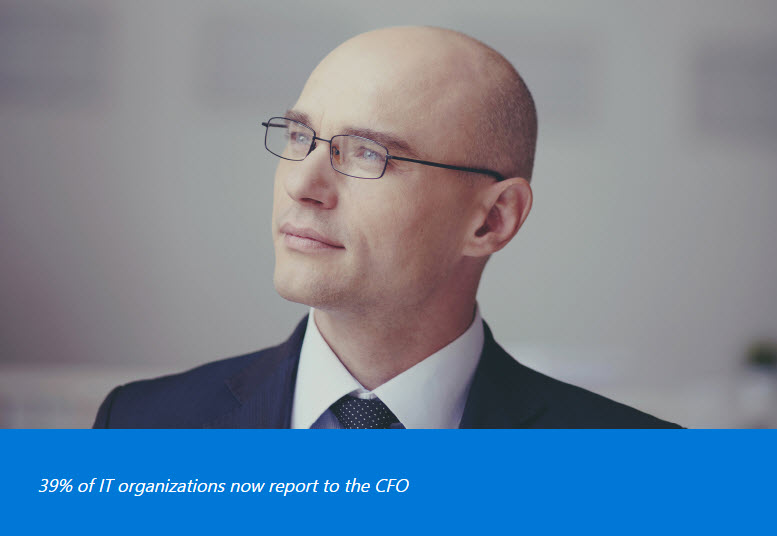The Rise of the Digital CFO
The emergence of the digital age is fundamentally changing the priorities and roles of today’s finance executives. Gone are the days when the majority of a CFO’s role involved overseeing accounting practices; while the traditional goals of finding new sources of revenue and reducing costs remain constant, a fresh focus on exploring new opportunities for growth is emerging. The role of today’s CFOs and finance executives must be much broader and require more technological sophistication. For example, 39% of IT organizations now report to the CFO, therefore a myriad of new technology purchasing decisions become part of the rewritten job description.

CONVERT DATA INTO VISUAL INSIGHTS AND IMPACT
shifting role of the CFO isn’t just relegated to the foray into the technology sphere. The explosion of big data and analytics has created a huge pool of previously unavailable resources by which business leaders can make more nuanced decisions, and it has created new possibilities for profound impact on the business. Today’s finance professional needs instant access to the insights necessary to make sound business decisions for their enterprise. This data access also makes it more possible to drive well-informed and streamlined corporate performance.
Of course, the availability and accessibility of big data has a darker side that has brought new questions. With all of those numbers to churn, are the systems able to efficiently process these massive quantities of information? What about the tools used to access, query, and visualize that data? And share it? These industry changes require business intelligence tools that are intuitive, scalable, and
easily integrate into a finance executive’s daily work. Tools that enable revenue growth by evaluating and responding to market opportunities, in real-time. Tools that empower impact and faster decisions with secure, instant access to visual data on any device.
For finance professionals, Excel was traditionally (and still is) the tool of choice for most day-to-day projects. But the Excel of today is much more powerful than its predecessors. Today’s Excel can take millions of rows of data and convert it into touch-enabled, interactive visual data that can be embedded into PowerPoint. Today’s Excel integrates with many popular business intelligence tools, like Microsoft Power BI or SAP Business Objects BI, and this integration makes it possible to uncover deeper insights. But the true power of the latest generation of these tools lies in the ability to anticipate business needs, staying ahead of costly incidents like unexpected maintenance and business downtime for customers. It is changing the way that finance professionals do their job while driving the transition from controllership to stewardship.

ASSESS AND CONTROL RISK WITH A SINGLE, INTEGRATED VIEW INTO YOUR ORGANIZATION
In addition to collecting and analyzing the massive amounts of corporate and customer data available, another trend among finance executives is to embrace cloud technologies to create a single, integrated view into the organization.
Data delivers great opportunity if it can be collected and securely accessed digitally from across the organization. Risks come in all shapes and sizes, and by migrating data into the cloud, enterprises can drive increased visibility to organizational risks with instant insights. From controllership risks to external risks, technology is now emerging as a key resource for finance executives eager to proactively identify potential issues that can then be assessed and remedied.
The beauty of Microsoft Cloud technologies lies in quick, easy, and secure tools that facilitate the transition facing many finance executives: migrating their unique data into the cloud. Our secure self-service tools give you one version of the truth so you can anticipate issues, and our collaboration tools help you react to them in real-time to control risk. This means you can control risks with a unified view into your business, enforce corporate policies, and address regulatory requirements that could adversely affect your business, all in one system that the whole business can access and share across devices.
In today’s on-the-go world, employees must be able to take action on ideas and opportunities from anywhere and connect socially with customers, partners, and vendors to anticipate and respond to their needs. In finance, where data often requires maximum security, selecting the mobile and social technologies that an enterprise can rely on and trust to protect sensitive information is critical. This is why today’s successful digital CFOs recognize that by empowering their workforce with secure productivity tools they can help their organization tackle anything from anywhere with the built-in security that protects the business

DRIVE CORPORATE STRATEGY THROUGH BECOMING MORE RESPONSIVE
Every finance executive knows the importance of agility when responding to a changing business landscape. Pressures mount from inside of the organization while threats to data, security, and customer information press from outside of the company. To compete, companies must be nimble enough to rapidly address changing market conditions without the need for major capital expenditures or complex communications. And while we all know the importance of agility and responsiveness, the details of exactly how to achieve and facilitate that nimble response can be the most opaque. There are two possible ways to boost this sought-after agility: ERP and the Microsoft Cloud.
ERP, at the center of most finance organizations, leverages a modern, flexible platform to streamline and unite processes across the enterprise. This facilitates the informed decision-making and rapid response that every finance professional needs. With ERP, finance executives can manage complexity and drive business agility by connecting people, operations, and partners with a single unified solution. And deployment of resources using cloud technology — public, private or hybrid — gives scalability. This scalability accelerates business transformation and gives finance executives the spending transparency needed to run a modern, lean, responsive business.

The rise of digital technology affects every executive in today’s modern enterprise, but perhaps no role is impacted more profoundly than that of finance. With the continuing evolution of the role of finance, many financial leaders are now tasked with balancing the traditional job requirements of accurate and timely financial reporting with new necessities, including setting the strategic technology direction of the company, discovering insights in a deluge of data, and driving corporate performance through the use of technology.
By implementing key technologies in the areas of business intelligence, cloud, mobile, social, and productivity, the role of today’s finance professional evolves from balance sheet manager to strategic leader. Today’s finance executives are in an unprecedented position to help their companies achieve their goals for profitability, growth, and productivity by addressing technology as a business priority, both strategically and tactically, and we’re here to help however we can.








